GPT-5 and AI in Recruiting: Everything You Need to Know About the Future of Coding and Beyond
The world of artificial intelligence has been abuzz with anticipation, and after years of waiting, GPT-5 has finally arrived. This new iteration from OpenAI promises to be a game-changer, especially in the realm of coding, which is rapidly becoming the focal point of AI development. In this comprehensive article, we will explore the key announcements, early impressions, benchmarks, and the profound implications GPT-5 holds—not just for software development but also for broader applications like AI in recruiting and knowledge work.
As we dive into this exploration, we will weave in insights from early testers, industry experts, and the broader AI community, capturing the excitement, skepticism, and hope that surrounds this launch. Let's unpack what GPT-5 means for creators, developers, businesses, and anyone interested in the cutting edge of AI technology.
The Evolution Leading to GPT-5
GPT-5 did not arrive out of nowhere. Its launch represents the culmination of years of relentless development and competition among AI models. For much of 2023 and into 2024, ChatGPT-4 was the undisputed leader in the large language model space. Other players scrambled to catch up, releasing models that were GPT-4 class or close to it.
However, the landscape began to shift in late 2024 with the rise of reasoning models and specialized AI tailored for different tasks. OpenAI's own GPT-3 remained a mainstay for many tasks, but Chinese open models like DeepSeek's R1 and the dominance of Anthropic's coding models (Claude 3.5 Sonnet through 3.7 Sonnet, Opus 4 and 4.1) began to challenge the status quo, especially in coding.
Google’s Gemini 2.5 also emerged as a strong contender, particularly because of its competitive pricing and performance balance. Nevertheless, Anthropic's models were considered the go-to for coding tasks for a considerable user base.
Against this backdrop, GPT-5 was poised to make a significant leap, with an emphasis on coding capabilities that OpenAI made clear in their announcement.
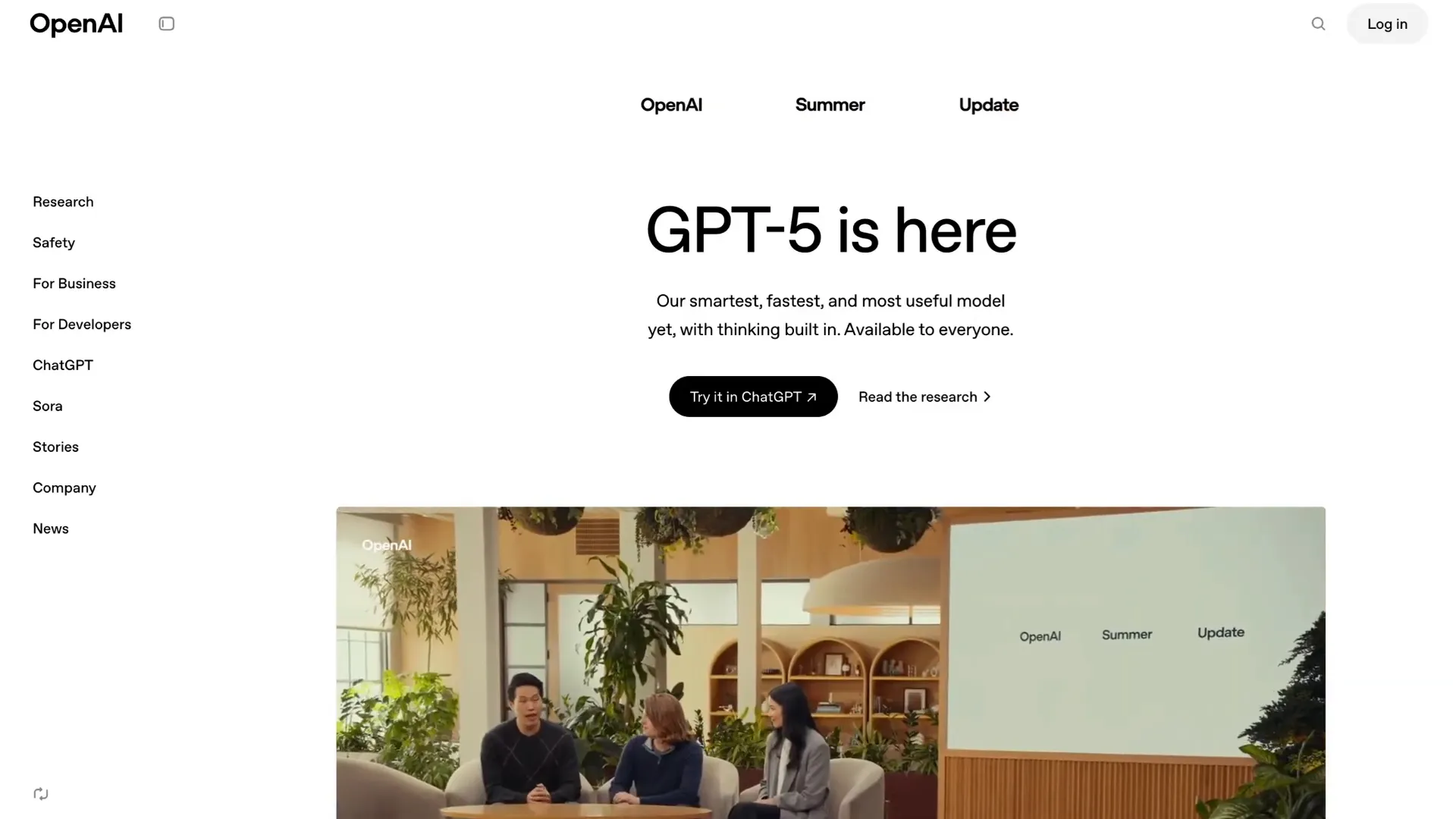
What OpenAI Announced: Models, Availability, and Initial Reactions
OpenAI introduced multiple versions of GPT-5: the standard GPT-5, GPT-5 Mini, and GPT-5 Nano. All versions boast a remarkable 400,000 token context length and competitive pricing, signaling OpenAI's intent to make this technology widely accessible.
The rollout has already begun for top-tier users, with plans to extend availability to education and business sectors shortly thereafter. The presentation itself was a lengthy hour and twenty minutes, but reactions were mixed. Some observers described the energy as unexpectedly subdued, even comparing the event's tone to a “funeral hosted by minimalists,” where groundbreaking technology was unveiled with a grayscale, somber mood.
Elon Musk himself chimed in, describing the launch as “underwhelming.” While this sentiment was not universally shared, there was a consensus that the presentation lacked the excitement one might expect for such a significant release.
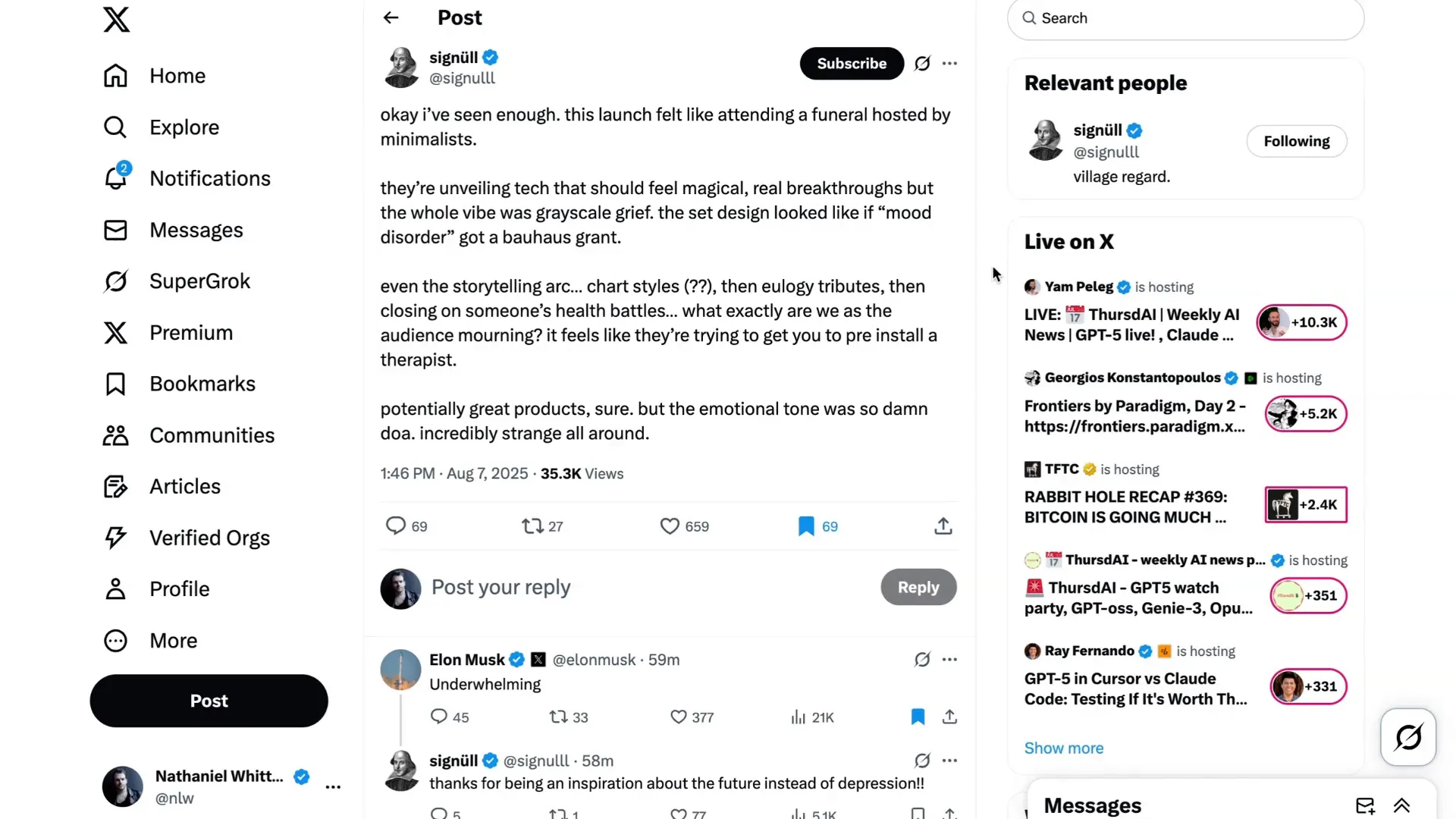
Benchmark Performance: The Numbers Behind the Model
Benchmarks are often the first metric by which AI models are judged, though their significance can sometimes be overstated. GPT-5 showed impressive results, particularly when compared to OpenAI’s own past models, but OpenAI notably refrained from comparing GPT-5’s performance against competitors like Anthropic’s Claude or Google’s Gemini in their official materials.
One of the most talked-about benchmarks was the Sweep Bench Verified, where GPT-5 showed notable improvements, though the presentation’s chart was somewhat confusing, sparking debate on social media.
On Humanity’s Last Exam, a test of reasoning and knowledge, GPT-5 scored 24.8% without tools, outperforming GPT-3’s 14.7%. With full tool access, GPT-5 Pro jumped to 42%, showcasing the power of AI agents equipped with external resources.
Independent benchmarks from Artificial Analysis confirmed GPT-5’s strong position, placing its high-end version at the top across multiple tests, including MMLU, AIME, and a proprietary long-context reasoning benchmark. Notably, GPT-5 pushed the limit on task duration success, maintaining a 50% success rate on tasks lasting over two hours, a significant leap for agentic AI capabilities.
However, on the ARC AGI test, GPT-5 lagged behind Grok 4, though its Mini version showed promise in efficiency, possibly breaking new ground in that frontier.
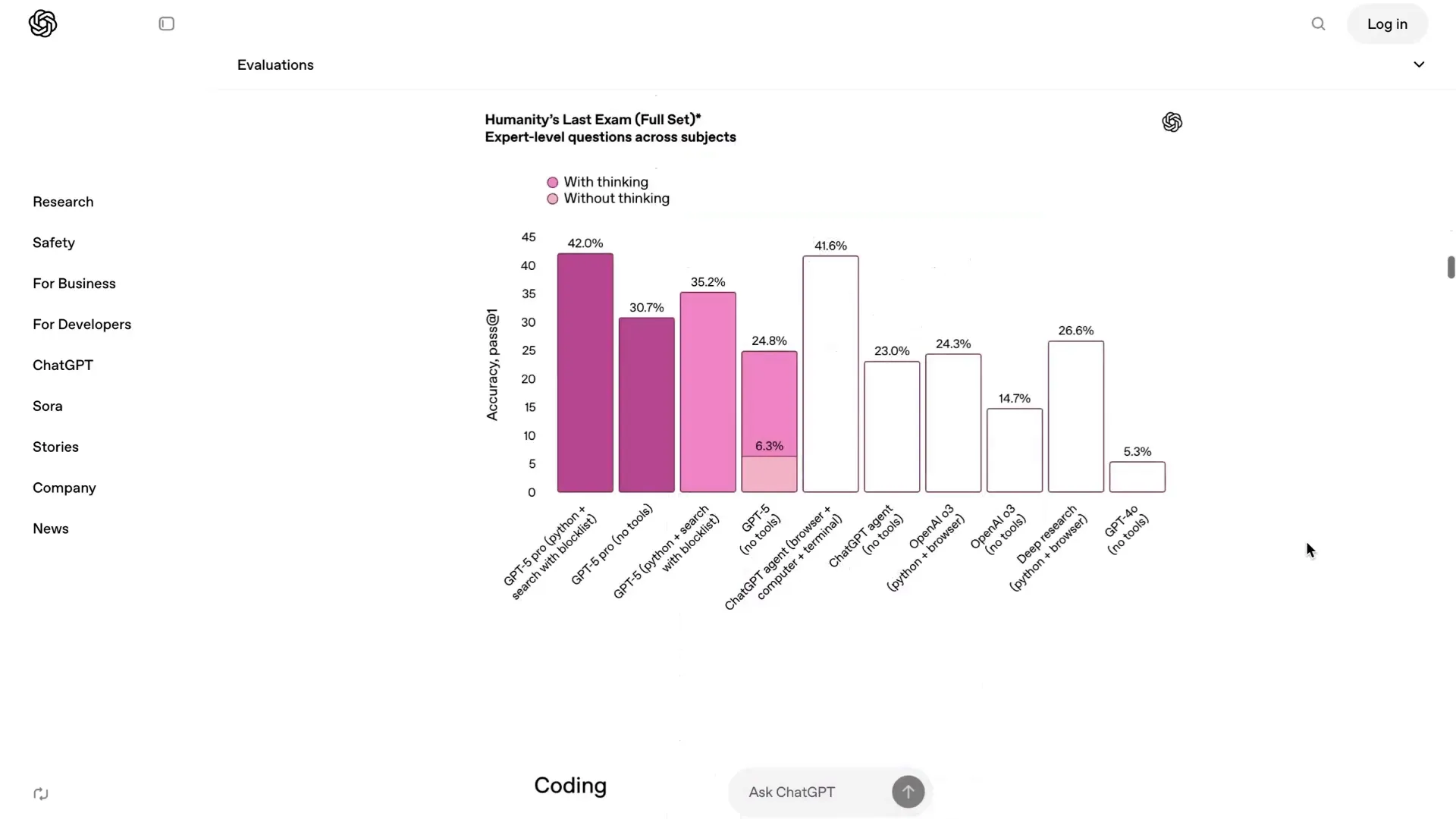
Reducing Hallucinations and Sycophancy: Day-to-Day Improvements
Beyond raw performance, OpenAI emphasized improvements in reducing hallucinations (false or misleading outputs) and sycophancy (overly agreeable or flattering responses). GPT-5 was trained with a reward signal aimed at minimizing sycophancy, making it less likely to blindly agree or provide biased answers.
These enhancements are crucial for real-world applications, where trustworthiness and reliability are paramount, especially in sensitive domains such as health and legal advice.
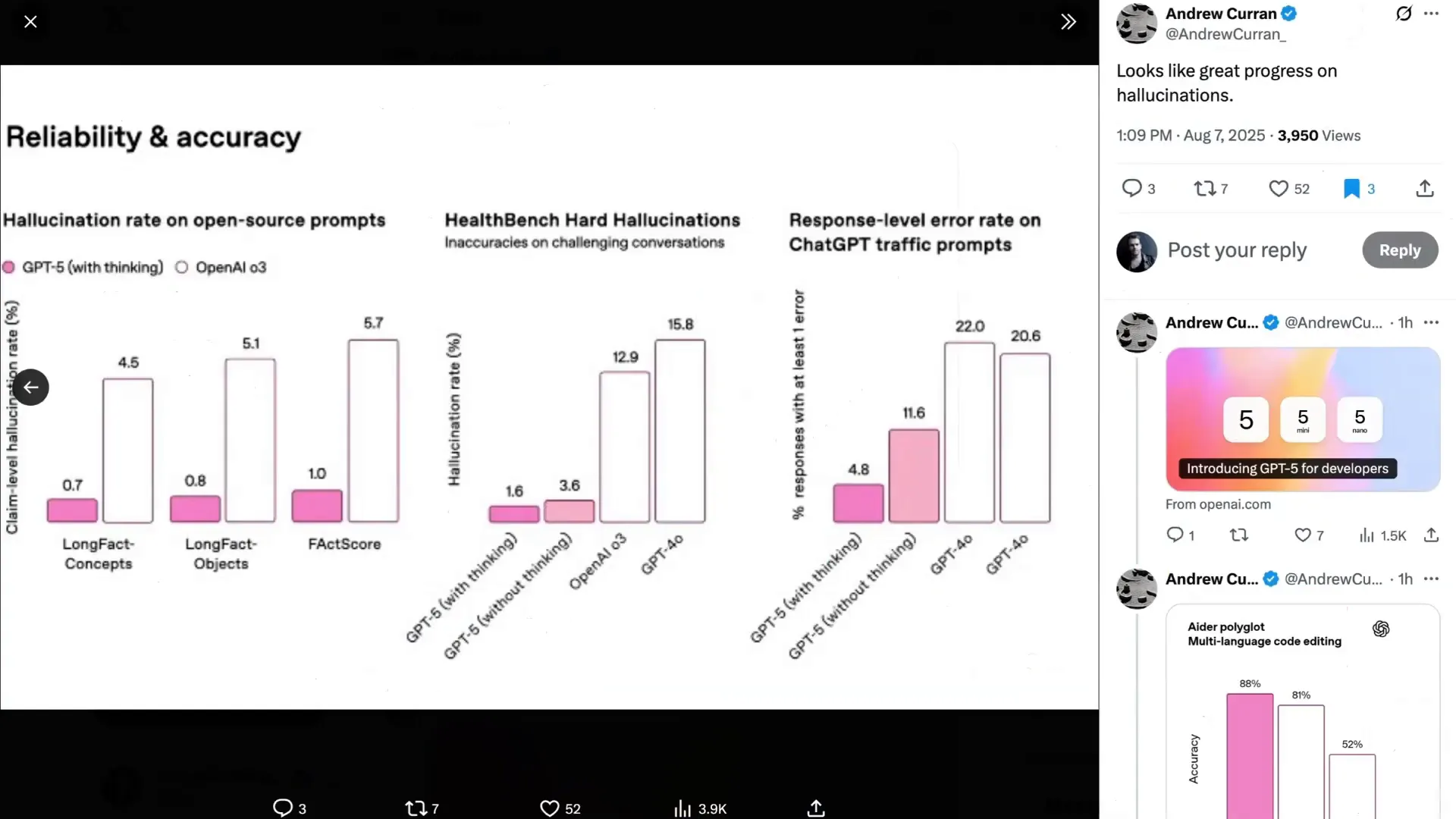
Key Use Cases: Health, Writing, and the Coding Revolution
OpenAI highlighted three major use cases for GPT-5: health, writing, and coding. While health and writing were discussed, coding clearly dominated the narrative, reflecting where OpenAI sees the most immediate and impactful application of their technology.
Health: Empowering Patients, Challenging the Status Quo
One of the more human-focused stories shared was about a cancer survivor who used ChatGPT to better advocate for herself, challenging doctors’ opinions and making more informed decisions about her treatment. This narrative underscores a brewing tension between AI and traditional medical authority.
Doctors have long been wary of patients self-diagnosing via internet searches; now, AI-generated advice is poised to complicate doctor-patient dynamics further. Elon Musk remarked that AI is already surpassing most doctors in knowledge and will only improve.
While this may cause friction, a more informed patient base is ultimately a positive development. Access to better information empowers individuals to make more nuanced decisions, even if it requires medical professionals to adapt their approach.

Writing: Mixed Reviews and Limited Breakthroughs
Writing was a split case. Early testers noted that GPT-5 excels at generating nuanced, expressive prose and polishing sentences without the typical “AI idioms.” For drafting and initial composition, it’s a valuable tool.
However, GPT-5 struggles with editing and judging the quality of writing, often failing benchmarks that previous models like Opus 4 passed. Some reviewers found GPT-5’s rewritten work sloppier than GPT-4.5 or DeepSeeker’s outputs.
For many professionals, this means GPT-5 may not replace human judgment in writing tasks anytime soon, especially for sensitive or emotionally complex communications.
AI Agents For Recruiters, By Recruiters |
|
Supercharge Your Business |
| Learn More |
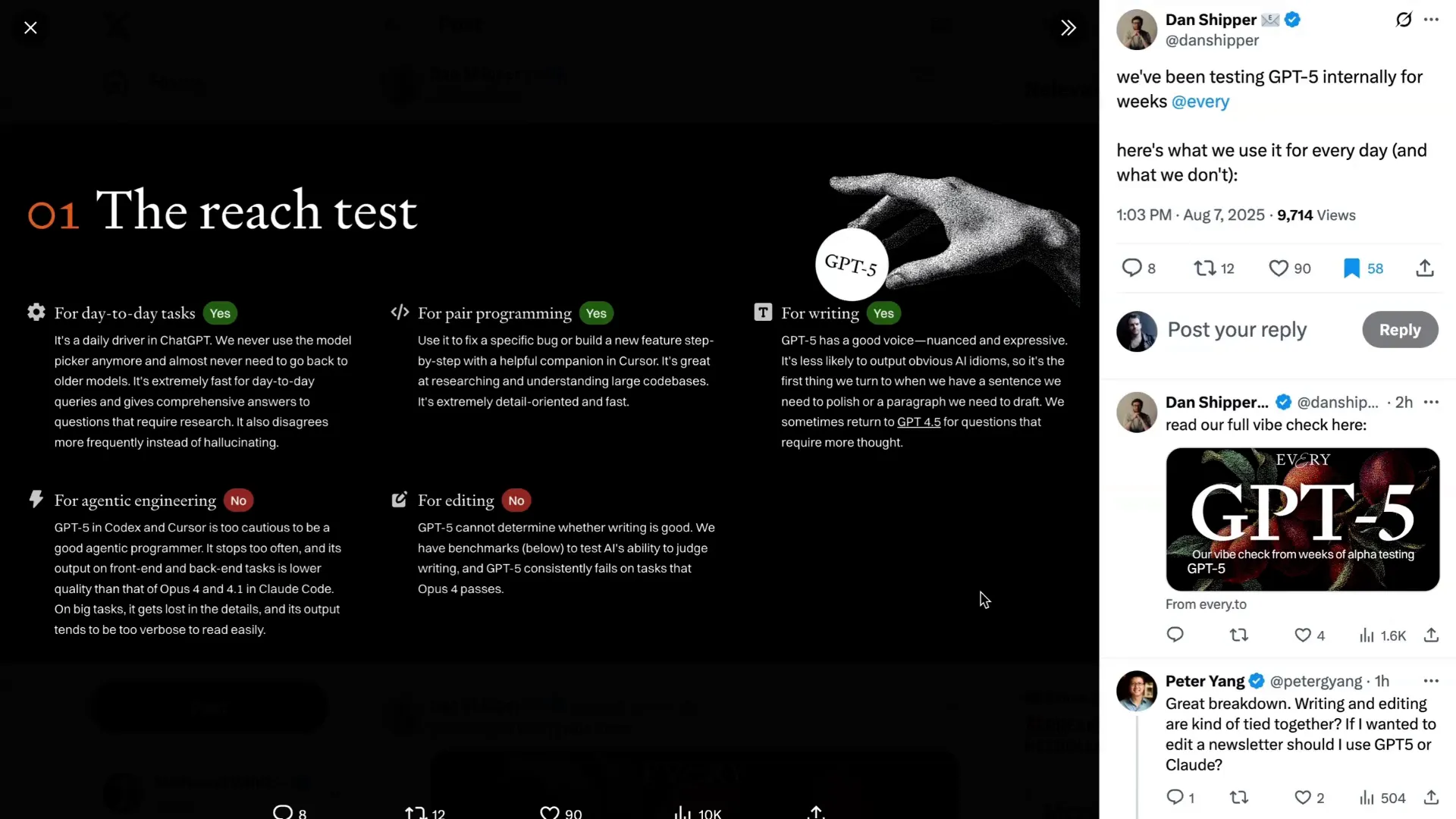
Coding: The Crown Jewel of GPT-5
Where GPT-5 truly shines is coding. OpenAI’s presentation and early reviews make it clear that coding is the use case they believe matters most right now. The CEO of Cursor, Michael Truel, called GPT-5 the smartest coding model they have tried, a sentiment echoed by many in the developer community.
GPT-5’s strength lies not only in raw benchmarks but in its ability to work as a collaborative partner, handling complex tasks, debugging, and refactoring thousands of lines of code with precision and speed. It is particularly impressive at running parallel tool operations, an important feature for complex software projects involving multiple files and dependencies.
Yet, some testers caution that GPT-5’s personality is more cautious and less autonomous than models like Claude Code, which has pioneered a new paradigm of “true delegation” in programming AI. Current tools like Cursor and OpenAI’s own Codec CLI focus more on pair programming than full autonomous coding.
The Stone Age of AI Agents: A New Era of Tool Use
Ben Hylock from Leighton Space offers a fascinating perspective, dubbing GPT-5 the start of the “Stone Age” for AI agents and large language models. Drawing an analogy to human evolution, he argues that the defining characteristic of intelligence is the ability to use tools. GPT-5 doesn’t just use tools—it thinks and builds with them.
Ben highlights GPT-5’s exceptional ability to handle complex, nested dependency conflicts and to debug large codebases autonomously. Unlike other models that gave up or offered guesses, GPT-5 iterated, reasoned, and succeeded in a single shot.
This marks a significant leap toward automating software engineering, pushing the field from approximately 65% to 72% automation, according to Ben—a leap comparable to the jump from GPT-3.5 to earlier models.
Implications for AI in Recruiting and Beyond
While the focus of the GPT-5 launch was heavily on coding, the implications reach far beyond software development. One area where AI’s growing capabilities intersect profoundly is recruiting. AI in recruiting is rapidly transforming how companies identify, assess, and engage talent.
GPT-5’s improved reasoning, tool use, and ability to handle complex workflows suggest it can power more sophisticated recruiting tools that go beyond keyword matching or simple chatbot interactions. Imagine AI agents that can:
- Analyze candidate profiles deeply, including portfolios and social media footprints.
- Conduct nuanced, multi-turn interviews that assess both skills and cultural fit.
- Automate complex administrative workflows, freeing recruiters to focus on human connection.
- Generate tailored job descriptions and candidate communications with a more natural, persuasive voice.
The democratization of coding via GPT-5 also means that customized recruiting tools can be built faster and more affordably, empowering smaller companies to compete with tech giants in attracting talent.
As GPT-5 and its successors become the default AI engines powering a wide range of applications, the synergy between AI in recruiting and software development will accelerate, creating smarter, more efficient, and more human-centric hiring processes.
Looking Ahead: Testing, Strategy, and the Future of Vibe Coding
The next phase for GPT-5 is hands-on experimentation. Early adopters are focusing on three areas:
- Strategy: Understanding how GPT-5 fits into daily workflows and long-term planning.
- Writing: Evaluating whether GPT-5 opens new possibilities or remains limited in certain creative or editorial tasks.
- Vibe Coding: Exploring the model’s ability to “vibe code” — rapidly generate complex, functional software with minimal human input.
This last point is especially exciting. The concept of vibe coding represents a shift from incremental code generation to autonomous software creation, where AI can take a project from concept to prototype in a single session. This lowers the barrier to entry for software creation, enabling more people to build sophisticated applications without traditional coding skills.
OpenAI’s pricing strategy also plays a critical role in adoption. GPT-5’s input and output costs are competitive with Google’s Gemini 2.5 and significantly cheaper than Anthropic’s offerings, making it accessible for a broad audience.
Ultimately, GPT-5 is not just a better coding assistant—it’s a catalyst for a new era of AI-powered creation and productivity, with ripple effects across industries, including AI in recruiting.
Conclusion: GPT-5 as a New Chapter in AI and Human Collaboration
GPT-5 marks a pivotal moment in the evolution of AI. While it may not be the long-anticipated AGI, it represents a significant leap forward, especially in the domain of coding and autonomous software engineering. The model’s enhanced reasoning, tool use, and collaborative abilities open doors to new kinds of projects and workflows previously thought impractical or impossible.
Its impact on AI in recruiting, knowledge work, and creative tasks will unfold over the coming months and years, but the trajectory is clear: AI is becoming an indispensable partner in human endeavors.
As we embrace this new technology, the challenge will be to harness it responsibly and thoughtfully, ensuring that the benefits of AI-driven innovation are widely shared and ethically guided.
For those eager to explore GPT-5, the journey has just begun. Dive in, experiment, and discover how this remarkable tool can transform your work and creativity.
Until next time, happy coding and recruiting with AI!